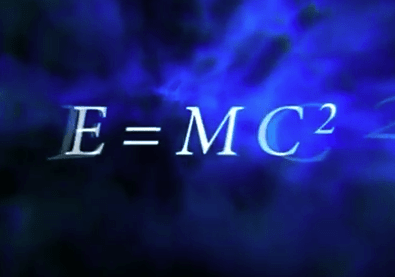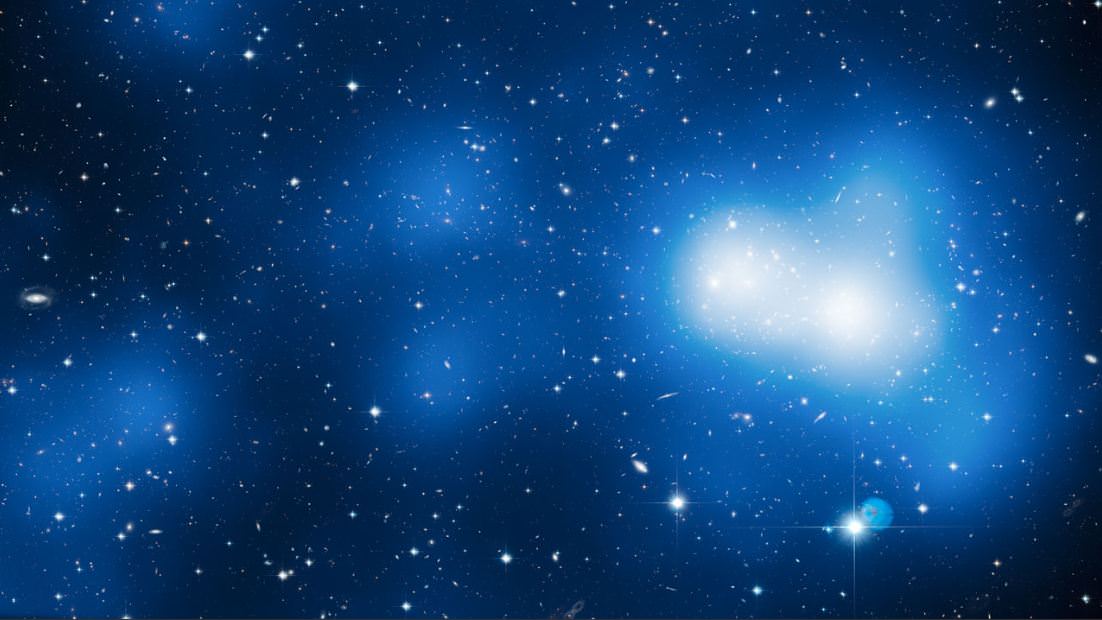One of the most amazing implications of Einstein’s relativity is the fact that the inertial mass of an object depends on its velocity. That sounds like a difficult thing to test, but that’s exactly what happened through a series of experiments performed by Kaufmann, Bucherer, Neumann and others.
Continue reading “Astronomy Cast Ep. 370: The Kaufmann–Bucherer–Neumann Experiments”
How Can Space Travel Faster Than The Speed Of Light?
Cosmologists are intellectual time travelers. Looking back over billions of years, these scientists are able to trace the evolution of our Universe in astonishing detail. 13.8 billion years ago, the Big Bang occurred. Fractions of a second later, the fledgling Universe expanded exponentially during an incredibly brief period of time called inflation. Over the ensuing eons, our cosmos has grown to such an enormous size that we can no longer see the other side of it.
But how can this be? If light’s velocity marks a cosmic speed limit, how can there possibly be regions of spacetime whose photons are forever out of our reach? And even if there are, how do we know that they exist at all?
The Expanding Universe
Like everything else in physics, our Universe strives to exist in the lowest possible energy state possible. But around 10-36 seconds after the Big Bang, inflationary cosmologists believe that the cosmos found itself resting instead at a “false vacuum energy” – a low-point that wasn’t really a low-point. Seeking the true nadir of vacuum energy, over a minute fraction of a moment, the Universe is thought to have ballooned by a factor of 1050.
Since that time, our Universe has continued to expand, but at a much slower pace. We see evidence of this expansion in the light from distant objects. As photons emitted by a star or galaxy propagate across the Universe, the stretching of space causes them to lose energy. Once the photons reach us, their wavelengths have been redshifted in accordance with the distance they have traveled.
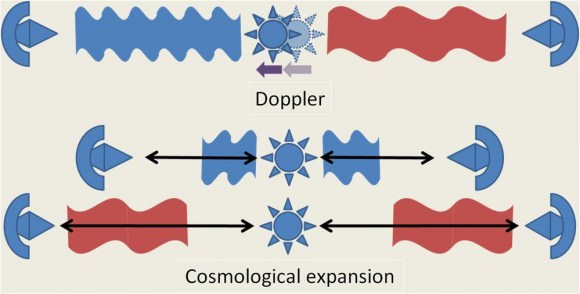
This is why cosmologists speak of redshift as a function of distance in both space and time. The light from these distant objects has been traveling for so long that, when we finally see it, we are seeing the objects as they were billions of years ago.
The Hubble Volume
Redshifted light allows us to see objects like galaxies as they existed in the distant past; but we cannot see all events that occurred in our Universe during its history. Because our cosmos is expanding, the light from some objects is simply too far away for us ever to see.
The physics of that boundary rely, in part, on a chunk of surrounding spacetime called the Hubble volume. Here on Earth, we define the Hubble volume by measuring something called the Hubble parameter (H0), a value that relates the apparent recession speed of distant objects to their redshift. It was first calculated in 1929, when Edwin Hubble discovered that faraway galaxies appeared to be moving away from us at a rate that was proportional to the redshift of their light.
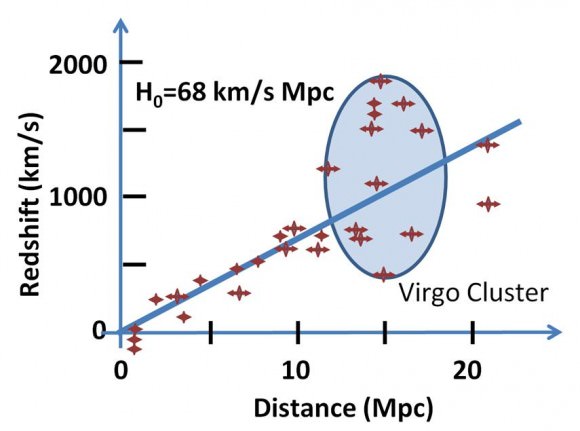
Dividing the speed of light by H0, we get the Hubble volume. This spherical bubble encloses a region where all objects move away from a central observer at speeds less than the speed of light. Correspondingly, all objects outside of the Hubble volume move away from the center faster than the speed of light.
Yes, “faster than the speed of light.” How is this possible?
The Magic of Relativity
The answer has to do with the difference between special relativity and general relativity. Special relativity requires what is called an “inertial reference frame” – more simply, a backdrop. According to this theory, the speed of light is the same when compared in all inertial reference frames. Whether an observer is sitting still on a park bench on planet Earth or zooming past Neptune in a futuristic high-velocity rocketship, the speed of light is always the same. A photon always travels away from the observer at 300,000,000 meters per second, and he or she will never catch up.
General relativity, however, describes the fabric of spacetime itself. In this theory, there is no inertial reference frame. Spacetime is not expanding with respect to anything outside of itself, so the the speed of light as a limit on its velocity doesn’t apply. Yes, galaxies outside of our Hubble sphere are receding from us faster than the speed of light. But the galaxies themselves aren’t breaking any cosmic speed limits. To an observer within one of those galaxies, nothing violates special relativity at all. It is the space in between us and those galaxies that is rapidly proliferating and stretching exponentially.
The Observable Universe
Now for the next bombshell: The Hubble volume is not the same thing as the observable Universe.
To understand this, consider that as the Universe gets older, distant light has more time to reach our detectors here on Earth. We can see objects that have accelerated beyond our current Hubble volume because the light we see today was emitted when they were within it.
Strictly speaking, our observable Universe coincides with something called the particle horizon. The particle horizon marks the distance to the farthest light that we can possibly see at this moment in time – photons that have had enough time to either remain within, or catch up to, our gently expanding Hubble sphere.
And just what is this distance? A little more than 46 billion light years in every direction – giving our observable Universe a diameter of approximately 93 billion light years, or more than 500 billion trillion miles.
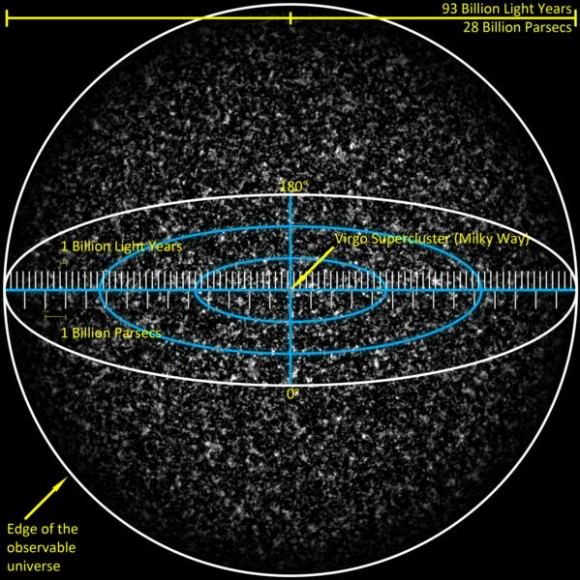
(A quick note: the particle horizon is not the same thing as the cosmological event horizon. The particle horizon encompasses all the events in the past that we can currently see. The cosmological event horizon, on the other hand, defines a distance within which a future observer will be able to see the then-ancient light our little corner of spacetime is emitting today.
In other words, the particle horizon deals with the distance to past objects whose ancient light that we can see today; the cosmological event horizon deals with the distance that our present-day light that will be able to travel as faraway regions of the Universe accelerate away from us.)
Dark Energy
Thanks to the expansion of the Universe, there are regions of the cosmos that we will never see, even if we could wait an infinite amount of time for their light to reach us. But what about those areas just beyond the reaches of our present-day Hubble volume? If that sphere is also expanding, will we ever be able to see those boundary objects?
This depends on which region is expanding faster – the Hubble volume or the parts of the Universe just outside of it. And the answer to that question depends on two things: 1) whether H0 is increasing or decreasing, and 2) whether the Universe is accelerating or decelerating. These two rates are intimately related, but they are not the same.
In fact, cosmologists believe that we are actually living at a time when H0 is decreasing; but because of dark energy, the velocity of the Universe’s expansion is increasing.
That may sound counterintuitive, but as long as H0 decreases at a slower rate than that at which the Universe’s expansion velocity is increasing, the overall movement of galaxies away from us still occurs at an accelerated pace. And at this moment in time, cosmologists believe that the Universe’s expansion will outpace the more modest growth of the Hubble volume.
So even though our Hubble volume is expanding, the influence of dark energy appears to provide a hard limit to the ever-increasing observable Universe.
Our Earthly Limitations
Cosmologists seem to have a good handle on deep questions like what our observable Universe will someday look like and how the expansion of the cosmos will change. But ultimately, scientists can only theorize the answers to questions about the future based on their present-day understanding of the Universe. Cosmological timescales are so unimaginably long that it is impossible to say much of anything concrete about how the Universe will behave in the future. Today’s models fit the current data remarkably well, but the truth is that none of us will live long enough to see whether the predictions truly match all of the outcomes.
Disappointing? Sure. But totally worth the effort to help our puny brains consider such mind-bloggling science – a reality that, as usual, is just plain stranger than fiction.
Don’t Look At Black Holes Too Closely, They Might Disappear
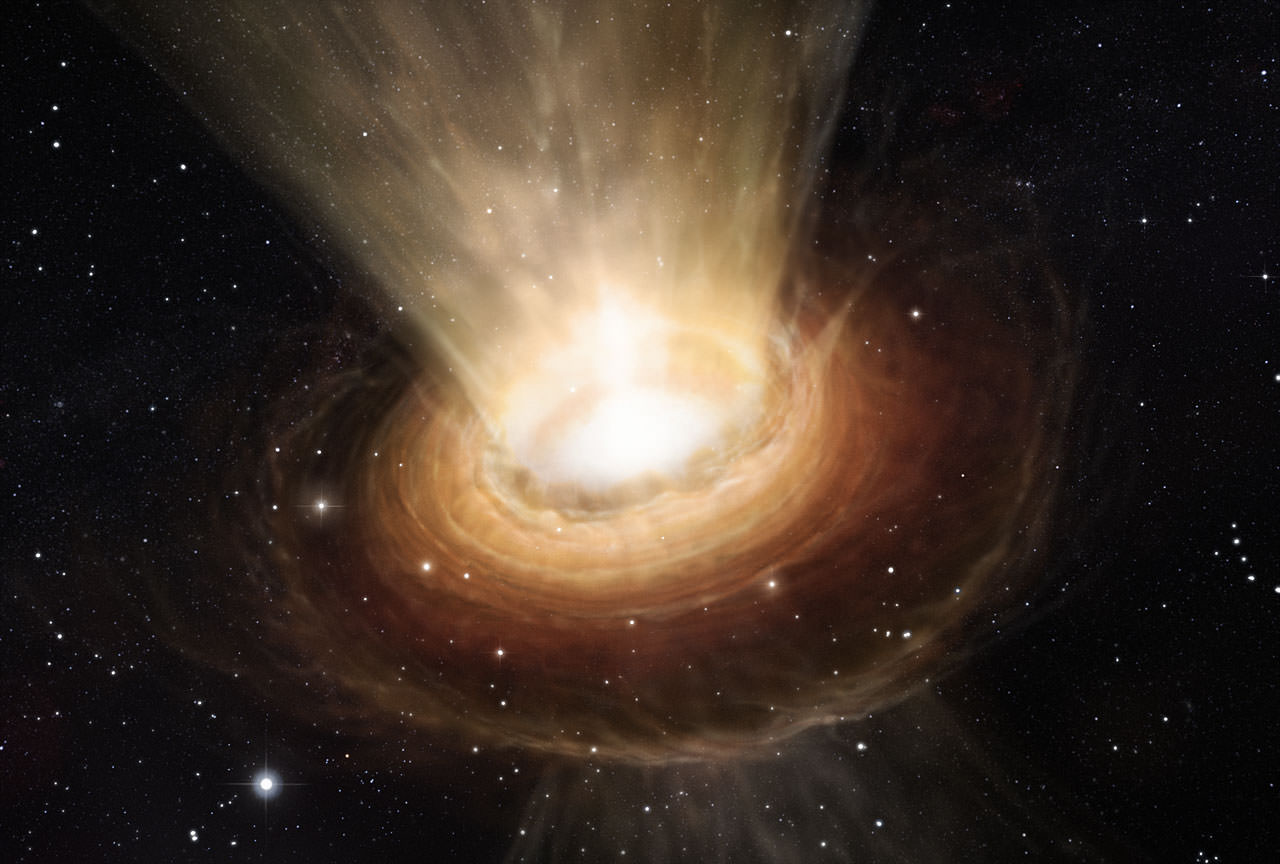
We’ve come a long way in 13.8 billion years; but despite our impressively extensive understanding of the Universe, there are still a few strings left untied. For one, there is the oft-cited disconnect between general relativity, the physics of the very large, and quantum mechanics, the physics of the very small. Then there is problematic fate of a particle’s intrinsic information after it falls into a black hole. Now, a new interpretation of fundamental physics attempts to solve both of these conundrums by making a daring claim: at certain scales, space and time simply do not exist.
Let’s start with something that is not in question. Thanks to Einstein’s theory of special relativity, we can all agree that the speed of light is constant for all observers. We can also agree that, if you’re not a photon, approaching light speed comes with some pretty funky rules – namely, anyone watching you will see your length compress and your watch slow down.
But the slowing of time also occurs near gravitationally potent objects, which are described by general relativity. So if you happen to be sight-seeing in the center of the Milky Way and you make the regrettable decision to get too close to our supermassive black hole’s event horizon (more sinisterly known as its point-of-no-return), anyone observing you will also see your watch slow down. In fact, he or she will witness your motion toward the event horizon slow dramatically over an infinite amount of time; that is, from your now-traumatized friend’s perspective, you never actually cross the event horizon. You, however, will feel no difference in the progression of time as you fall past this invisible barrier, soon to be spaghettified by the black hole’s immense gravity.
So, who is “correct”? Relativity dictates that each observer’s point of view is equally valid; but in this situation, you can’t both be right. Do you face your demise in the heart of a black hole, or don’t you? (Note: This isn’t strictly a paradox, but intuitively, it feels a little sticky.)
And there is an additional, bigger problem. A black hole’s event horizon is thought to give rise to Hawking radiation, a kind of escaping energy that will eventually lead to both the evaporation of the black hole and the destruction of all of the matter and energy that was once held inside of it. This concept has black hole physicists scratching their heads. Because according to the laws of physics, all of the intrinsic information about a particle or system (namely, the quantum wavefunction) must be conserved. It cannot just disappear.
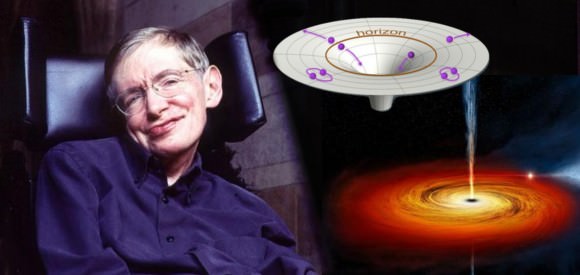
Why all of these bizarre paradoxes? Because black holes exist in the nebulous space where a singularity meets general relativity – fertile, yet untapped ground for the elusive theory of everything.
Enter two interesting, yet controversial concepts: doubly special relativity and gravity’s rainbow.
Just as the speed of light is a universally agreed-upon constant in special relativity, so is the Planck energy in doubly special relativity (DSR). In DSR, this value (1.22 x 1019 GeV) is the maximum energy (and thus, the maximum mass) that a particle can have in our Universe.
Two important consequences of DSR’s maximum energy value are minimum units of time and space. That is, regardless of whether you are moving or stationary, in empty space or near a black hole, you will agree that classical space breaks down at distances shorter than the Planck length (1.6 x 10-35 m) and classical time breaks down at moments briefer than the Planck time (5.4 x 10-44 sec).
In other words, spacetime is discrete. It exists in indivisible (albeit vanishingly small) units. Quantum below, classical above. Add general relativity into the picture, and you get the theory of gravity’s rainbow.
Physicists Ahmed Farag Ali, Mir Faizal, and Barun Majumder believe that these theories can be used to explain away the aforementioned black hole conundrums – both your controversial spaghettification and the information paradox. How? According to DSR and gravity’s rainbow, in regions smaller than 1.6 x 10-35 m and at times shorter than 5.4 x 10-44 sec… the Universe as we know it simply does not exist.
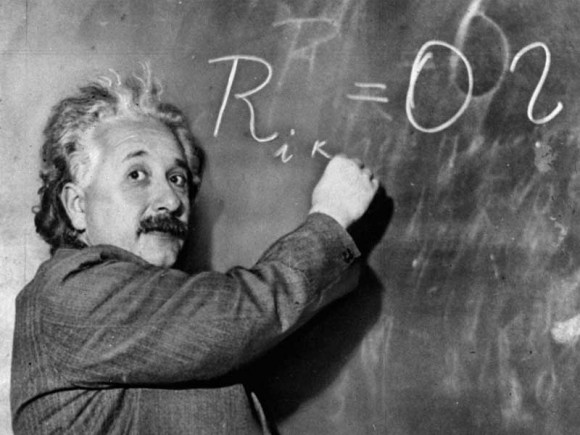
“In gravity’s rainbow, space does not exist below a certain minimum length, and time does not exist below a certain minimum time interval,” explained Ali, who, along with Faizal and Majumder, authored a paper on this topic that was published last month. “So, all objects existing in space and occurring at a time do not exist below that length and time interval [which are associated with the Planck scale].”
Luckily for us, every particle we know of, and thus every particle we are made of, is much larger than the Planck length and endures for much longer than the Planck time. So – phew! – you and I and everything we see and know can go on existing. (Just don’t probe too deeply.)
The event horizon of a black hole, however, is a different story. After all, the event horizon isn’t made of particles. It is pure spacetime. And according to Ali and his colleagues, if you could observe it on extremely short time or distance scales, it would cease to have meaning. It wouldn’t be a point-of-no-return at all. In their view, the paradox only arises when you treat spacetime as continuous – without minimum units of length and time.
“As the information paradox depends on the existence of the event horizon, and an event horizon like all objects does not exist below a certain length and time interval, then there is no absolute information paradox in gravity’s rainbow. The absence of an effective horizon means that there is nothing absolutely stopping information from going out of the black hole,” concluded Ali.
No absolute event horizon, no information paradox.
And what of your spaghettification within the black hole? Again, it depends on the scale at which you choose to analyze your situation. In gravity’s rainbow, spacetime is discrete; therefore, the mathematics reveal that both you (the doomed in-faller) and your observer will witness your demise within a finite length of time. But in the current formulation of general relativity, where spacetime is described as continuous, the paradox arises. The in-faller, well, falls in; meanwhile, the observer never sees the in-faller pass the event horizon.
“The most important lesson from this paper is that space and time exist only beyond a certain scale,” said Ali. “There is no space and time below that scale. Hence, it is meaningless to define particles, matter, or any object, including black holes, that exist in space and time below that scale. Thus, as long as we keep ourselves confined to the scales at which both space and time exist, we get sensible physical answers. However, when we try to ask questions at length and time intervals that are below the scales at which space and time exist, we end up getting paradoxes and problems.”
To recap: if spacetime continues on arbitrarily small scales, the paradoxes remain. If, however, gravity’s rainbow is correct and the Planck length and the Planck time are the smallest unit of space and time that fundamentally exist, we’re in the clear… at least, mathematically speaking. Unfortunately, the Planck scales are far too tiny for our measly modern particle colliders to probe. So, at least for now, this work provides yet another purely theoretical result.
The paper was published in the January 23 issue of Europhysics Letters. A pre-print of the paper is available here.
What is Gravitational Lensing?
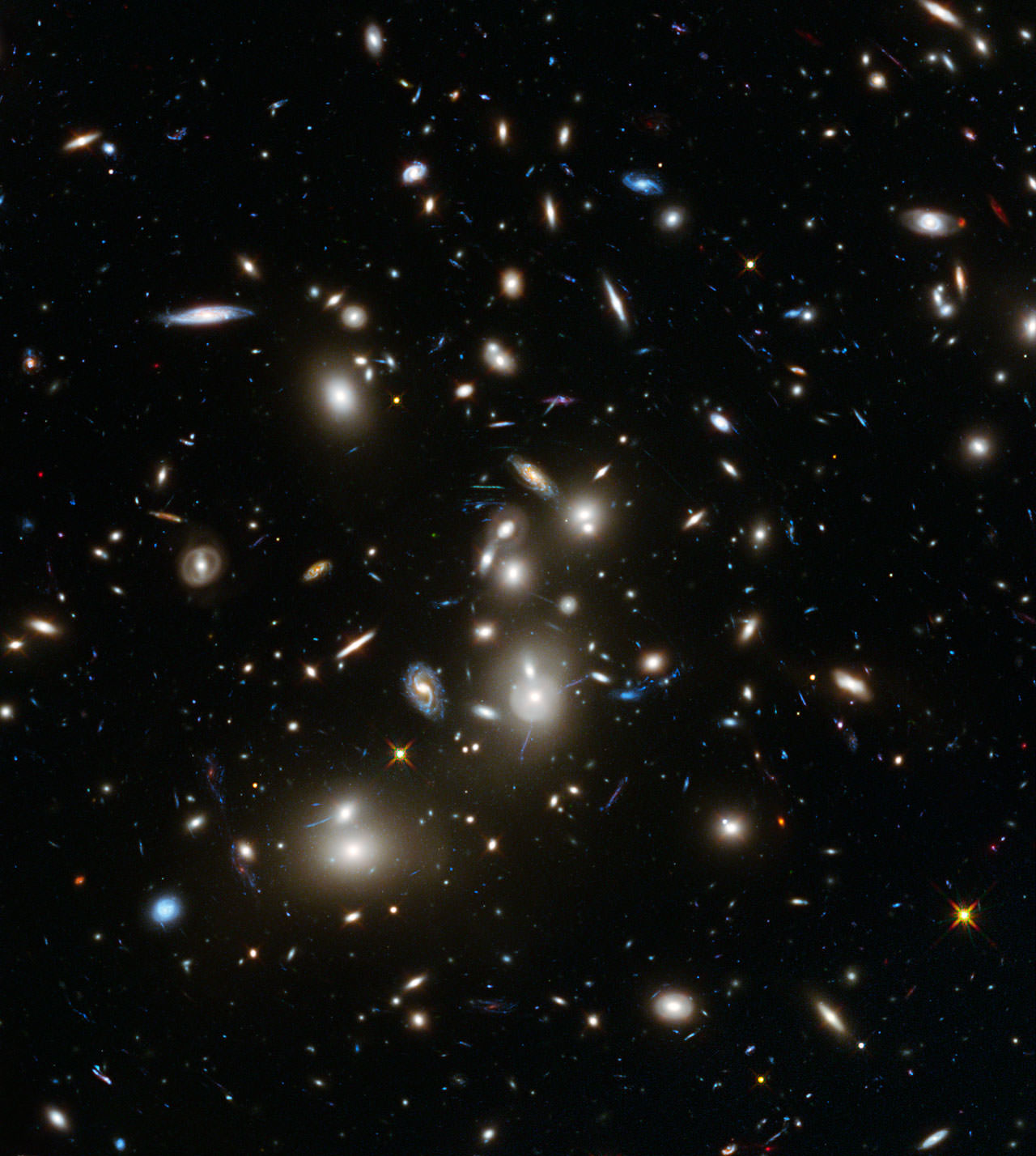
Gravity’s a funny thing. Not only does it tug away at you, me, planets, moons and stars, but it can even bend light itself. And once you’re bending light, well, you’ve got yourself a telescope.
Everyone here is familiar with the practical applications of gravity. If not just from exposure to Loony Tunes, with an abundance of scenes with an anthropomorphized coyote being hurled at the ground from gravitational acceleration, giant rocks plummeting to a spot inevitably marked with an X, previously occupied by a member of the “accelerati incredibilus” family and soon to be a big squish mark containing the bodily remains of the previously mentioned Wile E. Coyote.
Despite having a very limited understanding of it, Gravity is a pretty amazing force, not just for decimating a infinitely resurrecting coyote, but for keeping our feet on the ground and our planet in just the right spot around our Sun. The force due to gravity has got a whole bag of tricks, and reaches across Universal distances. But one of its best tricks is how it acts like a lens, magnifying distant objects for astronomy.
Continue reading “What is Gravitational Lensing?”How are Energy and Matter the Same?
As Einstein showed us, light and matter and just aspects of the same thing. Matter is just frozen light. And light is matter on the move. How does one become the other?
Albert Einstein’s most famous equation says that energy and matter are two sides of the same coin.
But what does that really mean? And how are equations famous? I like to believe equations can be famous in the way a work of art, or a philosophy can be famous. People can have awareness of the thing, and yet never have interacted with it. They can understand that it is important, and yet not understand why it’s so significant. Which is a little too bad, as this is really a lovely mind bending idea.
The origin of E=mc2 lies in special relativity. Light has the same speed no matter what frame of reference you are in. No matter where you are, or how fast you’re going. If you were standing still at the side of the road, and observed a car traveling at ¾ light speed, you would see the light from their headlights traveling away from them at ¼ the speed of light.
But the driver of the car would still see that the light moving ahead of them at the speed of light. This is only possible if their time appears to slow down relative to you, and you and the people in the car can no longer agree on how long a second would take to pass.
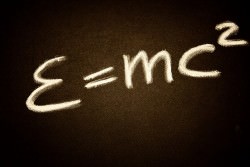
So the light appears to be moving away from them more slowly, but as they experience things more slowly it all evens out. This also affects their apparent mass. If they step on the gas, they will speed up more slowly than you would expect. It’s as if the car has more mass than you expect. So relativity requires that the faster an object moves, the more mass it appears to have. This means that somehow part of the energy of the car’s motion appears to transform into mass. Hence the origin of Einstein’s equation. How does that happen? We don’t really know. We only know that it does.
The same effect occurs with quantum particles, and not just with light. A neutron, for example, can decay into a proton, electron and anti-neutrino. The mass of these three particles is less than the mass of a neutron, so they each get some energy as well. So energy and matter are really the same thing. Completely interchangeable. And finally, Although energy and mass are related through special relativity, mass and space are related through general relativity. You can define any mass by a distance known as its Schwarzschild radius, which is the radius of a black hole of that mass. So in a way, energy, matter, space and time are all aspects of the same thing.
What do you think? Like E=mc2, what’s the most famous idea you can think of in physics?
And if you like what you see, come check out our Patreon page and find out how you can get these videos early while helping us bring you more great content!
What Would It Be Like To Fall Into A Black Hole?

Let’s say you happened to fall into the nearest black hole? What would you experience and see? And what would the rest of the Universe see as this was happening?
Let’s say you decided to ignore some of my previous advice. You’ve just purchased yourself a space dragon from the Market on the Centauri Ringworld, strapped on your favorite chainmail codpiece and sonic sword and now you’re going ride head first into the nearest black hole.
We know it won’t take you to another world or galaxy, but what would you experience and see on your way to your inevitable demise? And what would the rest of the Universe see as this was happening, and would they point and say “eewwwwww”?
If you were falling toward a black hole, most of the time you would simply feel weightless, just as if you were playing Bowie songs and floating in a most peculiar way in the International Space Station. The gravity of a black hole is just like the gravity of any other large mass, as long as you don’t get too close. But, as we’ve agreed, you’re ignoring my advice and flying dragon first into this physics nightmare. As you get closer, the gravitational forces on various parts of your and your dragon’s body would be different. Technically this is always true, but you wouldn’t notice it… at least at first.
Suppose you were falling feet first toward a black hole. As you got closer, your feet would feel a stronger force than your head, for example. These differences in forces are called tidal forces. Because of the tidal forces it would feel as if you are being stretched head to toe, while your sides would feel like they are being pushed inward. Eventually the tidal forces would become so strong that they would rip you apart. This effect of tidal stretching is sometimes boringly referred to as spaghettification.
I’ve made up some other names for it, such as My Own Private String Cheese Incident, “the soft-serve effect” and “AAAHHHHH AHHHH MY LEGS MY LEGS!!!”.
So, let’s summarize. You wouldn’t survive falling toward a black hole because you wouldn’t listen. Why won’t you ever listen?
A friend watching you fall toward a black hole would never see you reach the black hole. As you fall towards it, gravity would cause any light coming from you to be redshifted. So as you approached the black hole you would appear more and more reddish, and your image would appear dimmer and dimmer. Your friend would see you redden and dim as you approach, but never quite reach, the event horizon of the black hole. If they could still see you past this point, there would be additional red from the inside of you clouding up the view.
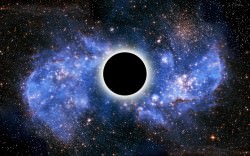
Hypothetically, if you could survive crossing the event horizon of a black hole, what
would you see then? Contrary to popular belief, you would not see the entire future of the universe flash before you.
What you would see is the darkness of the black hole fill your view and as you approached the event horizon you would see stars and galaxies on the edge of your view being gravitationally lensed by the black hole. The sky would simply appear more and more black until you reach the event horizon.
Many people think that it is at the event horizon where you would be ripped apart, and at the event horizon all sorts of strange things occur. Unfortunately, this goes along with those who suspect black holes are actually some sort of portal. For a solar mass black hole, the tidal forces near the event horizon can be quite large, but for a supermassive black hole they aren’t very large at all.
In fact, the larger the black hole, the weaker the tidal forces near its event horizon. So if you happened to be near a supermassive black hole, you could cross the event horizon without really noticing. Would you still be totally screwed? YOU BETCHA!
What do you think? If you could drop anything into a black hole, what would it be? Tell us in the comments below.
What Time is It in the Universe?
Check your watch, what time is it? But wait, you’ve actually been moving and accelerating, and according to Einstein, everything’s relative. So what time is it really? It all depends…
Flavor Flav knows what time it is. At least he does for Flavor Flav. Even with all his moving and accelerating, with the planet, the solar system, getting on planes, taking elevators, and perhaps even some light jogging. In the immortal words of Kool Moe Dee. Do you know what time it is?
Didn’t Einstein tell us it’s all relative? Does anyone actually know what time it is? I mean, aside from figuratively, or in a political sense, or perhaps as part of rap performance from whence the power is being fought from, requiring the sick skills of a hype man wearing a clock around his neck on a big chain.
So, after all my fancy dancing and longing for a time in rap and hip hop from days gone by, I must present to you “faithful audience member” an answer in the form of your 3 least favorite words I get to deliver.
It all depends…
You have heard that everything is relative, usually we hear it from people who like to talk about “connections on many different levels”, which is just nonsense.
But in physics “everything” is relative in a very particular way. Everything is relative to the speed of light, which is the same in every reference frame. Which is confusing and repeated enough that it can become meaningless.
So I’m going to do my best to explain it. If I shine a flashlight in front of me, I will measure the beam to travel at about 300,000 km/s, which is also known as the speed of light.
And if you are moving at 200,000 km/s faster than me, and shine a flashlight ahead of you, I will see the light from your flashlight moving at the 300,000km/s. It will appear to me, as though the light from your flashlight is moving away from you at 100,000 km/s.
But when you will measure the speed of that light, relative to you, you’d think it’d be moving at 100,000 km/s as well, but instead from your perspective it will ALSO clock in at 300,000 km/s.
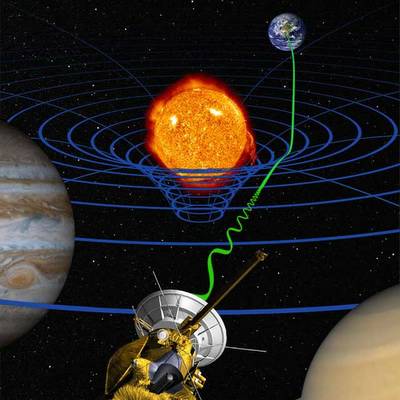
The speed of light. How is this even possible? It is possible in part because the rate at which you experience time relative to me changes. For you, time will seem normal, but from my perspective your time will seem slower. We agree on how fast light is moving in kilometers per second, but we disagree how long a second is. We also, by the way, disagree on the length of a meter.
This seems strange because we imagine that space and time are absolute things, and light is something that travels through space. This is our experience. Suggesting things like time and space are malleable values at best is unsettling and at worst will make us nanners from thinking too much about.
Hold on to your tinfoil hats, for it is in fact light that is the absolute, and space and time are relative to it. So what time it is depends upon your vantage point, and so there is no single absolute time.
Finally, because of relativity, each point in the Universe experiences time at a slightly different rate. For example, when we observe the cosmic microwave background, we find that we are moving at a speed of about 630 km/s relative to the background. That means we experience time a bit more slowly that something at rest relative to the cosmic background.
It’s just a tiny bit slower, but added over the entire age of the Universe, our cosmic clock is 30,000 years behind the times. Feel free to set your watch. But don’t get too precise about it. Your time could be off by tens of thousands of years.
What about you? What’s your favorite way to explain special relativity to someone. Tell us in the comments below.
Does Light Experience Time?
Have you ever noticed that time flies when you’re having fun? Well, not for light. In fact, photons don’t experience any time at all. Here’s a mind-bending concept that should shatter your brain into pieces.
As you might know, I co-host Astronomy Cast, and get to pick the brain of the brilliant astrophysicist Dr. Pamela Gay every week about whatever crazy thing I think of in the shower. We were talking about photons one week and she dropped a bombshell on my brain. Photons do not experience time. [SNARK: Are you worried they might get bored?]
Just think about that idea. From the perspective of a photon, there is no such thing as time. It’s emitted, and might exist for hundreds of trillions of years, but for the photon, there’s zero time elapsed between when it’s emitted and when it’s absorbed again. It doesn’t experience distance either. [SNARK: Clearly, it didn’t need to borrow my copy of GQ for the trip.]
Since photons can’t think, we don’t have to worry too much about their existential horror of experiencing neither time nor distance, but it tells us so much about how they’re linked together. Through his Theory of Relativity, Einstein helped us understand how time and distance are connected.
Let’s do a quick review. If we want to travel to some distant point in space, and we travel faster and faster, approaching the speed of light our clocks slow down relative to an observer back on Earth. And yet, we reach our destination more quickly than we would expect. Sure, our mass goes up and there are enormous amounts of energy required, but for this example, we’ll just ignore all that.
If you could travel at a constant acceleration of 1 g, you could cross billions of light years in a single human generation. Of course, your friends back home would have experienced billions of years in your absence, but much like the mass increase and energy required, we won’t worry about them.
The closer you get to light speed, the less time you experience and the shorter a distance you experience. You may recall that these numbers begin to approach zero. According to relativity, mass can never move through the Universe at light speed. Mass will increase to infinity, and the amount of energy required to move it any faster will also be infinite. But for light itself, which is already moving at light speed… You guessed it, the photons reach zero distance and zero time.
Photons can take hundreds of thousands of years to travel from the core of the Sun until they reach the surface and fly off into space. And yet, that final journey, that could take it billions of light years across space, was no different from jumping from atom to atom.
There, now these ideas can haunt your thoughts as they do mine. You’re welcome. What do you think? What’s your favorite mind bending relativity side effect? Tell us in the comments below.
The Secret of the Stars
“Say, do you like mystery stories? Well we have one for you. The concept: relativity.”
Well look at that, it’s a new video from John D. Boswell — aka melodysheep — which goes into autotuned detail about one of the standard principles of astrophysics, Einstein’s theory of general relativity.
Featuring clips from Michio Kaku, Brian Cox, Neil deGrasse Tyson, Brian Greene and Lisa Randall, I’d say E=mc(awesome).
John has been entertaining science fans with his Symphony of Science mixes since 2009, when his first video in the series — “A Glorious Dawn” featuring Carl Sagan — was released. Now John’s videos are eagerly anticipated by fans (like me) who follow him on YouTube and on Twitter as @musicalscience.
“E = mc2… that is the engine that lights up the stars.”
(What does Einstein’s famous mass-energy equivalence equation mean? For a brief and basic explanation, check out the American Museum of Natural History’s page here.)
Do We Really Need Dark Matter?
Hubble mosaic of massive galaxy cluster MACS J0717.5+3745, thought to be connected by a filament of dark matter. Credit: NASA, ESA, Harald Ebeling (University of Hawaii at Manoa) & Jean-Paul Kneib (LAM)
Even though teams of scientists around the world are at this very moment hot on the trail of dark matter — the “other stuff” that the Universe is made of and supposedly accounts for nearly 80% of the mass that we can’t directly observe (yet) — and trying to quantify exactly how so-called “dark energy” drives its ever-accelerating expansion, perhaps one answer to these ongoing mysteries is maybe they don’t exist at all.
This is precisely what one astronomer is suggesting in a recent paper, submitted Dec. 3 to Astrophysical Journal Letters.
In a paper titled “An expanding universe without dark matter and dark energy” (arXiv:1212.1110) Pierre Magain, a professor at Belgium’s Institut d’Astrophysique et de Géophysique, proposes that the expansion of the Universe could be explained without the need for enigmatic material and energy that, to date, has yet to be directly measured.
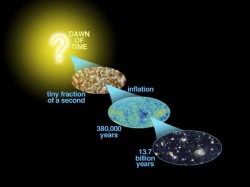 In addition, Magain’s proposal puts a higher age to the Universe than what’s currently accepted. With a model that shows a slower expansion rate during the early Universe than today, Magain’s calculations estimate its age to be closer to 15.4 – 16.5 billion years old, adding a couple billion more candles to the cosmic birthday cake.
In addition, Magain’s proposal puts a higher age to the Universe than what’s currently accepted. With a model that shows a slower expansion rate during the early Universe than today, Magain’s calculations estimate its age to be closer to 15.4 – 16.5 billion years old, adding a couple billion more candles to the cosmic birthday cake.
The benefit to a slightly older Universe, Magain posits, is that it’s not so uncannily close to the apparent age of the most distant galaxies recently found — such as MACS0647-JD, which is 13.3 billion light-years away and thus (based on current estimates, see graphic at right) must have formed when the Universe was a mere 420 million years old.
Read more: Now Even Further: Ancient Galaxy is Latest Candidate for Most Distant
Using accepted physics of how time behaves based on Einstein’s theory of general relativity — namely, how the passage of time is relative to the position and velocity of the viewer (as well as the intensity of the gravitational field the viewer is within) — Magain’s model allows for an observer located within the Universe to potentially be experiencing a different rate of time than a hypothetical viewer located outside the Universe. Not to be so metaphysical as to presume that there are external observers of our Universe but merely to say that an external point would be a fixed one against which one could benchmark a varying passage of time inside the Universe, Magain calls this universal relativity.
A viewer experiencing universal relativity would, Magain claims, always measure the curvature of the Universe to be equal to zero. This is what’s currently observed, a “flatness problem” that Magain insinuates is strangely coincidental.
By attributing an expanding Universe to dark energy and the high velocities of stars along the edges of galaxies (as well as the motions of galaxy clusters themselves) to dark matter, we may be introducing ad hoc elements to the Universe, says Magain. Instead, he proposes his “more economical” model — which uses universal relativity — explains these apparently accelerating, increasingly expanding behaviors… and gives a bigger margin of time between the Big Bang and the formation of the first galactic structures.
Read more: First Images in a New Hunt for Dark Energy
There’s quite a bit of math involved, and since I never claimed to understand physics equations you can check out the original paper here.
 While intriguing, the bottom line is that dark energy and dark matter have still managed to elude science, existing just outside the borders of what can be observed (although the gravitational lensing effects of what’s thought to be dark matter filaments have been observed by Hubble) and Magain’s paper is merely putting another idea onto the table — one that, while he recognizes needs further testing and relies upon very specific singular parameters, doesn’t depend upon invisible, unobservable and mysteriously dark “stuff”. Whether it belongs on the table or not will be up to other astrophysicists to decide.
While intriguing, the bottom line is that dark energy and dark matter have still managed to elude science, existing just outside the borders of what can be observed (although the gravitational lensing effects of what’s thought to be dark matter filaments have been observed by Hubble) and Magain’s paper is merely putting another idea onto the table — one that, while he recognizes needs further testing and relies upon very specific singular parameters, doesn’t depend upon invisible, unobservable and mysteriously dark “stuff”. Whether it belongs on the table or not will be up to other astrophysicists to decide.
Prof. Magain’s research was supported by ESA and the Belgian Science Policy Office.
At right: Artist’s impression of dark matter (h/t to Steve Nerlich)
Note: this is “just” a submitted paper and has not been selected for publication yet. Any hypotheses proposed are those of the author and are not endorsed by this site. (Personally I like dark matter. It’s fascinating stuff… even if we can’t see it. Want an astrophysicist’s viewpoint on the existence of dark matter? Check out Ethan Siegel’s blog response here.)






